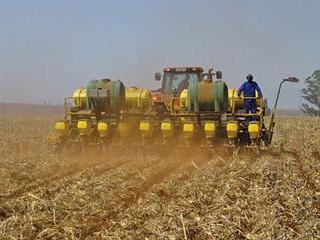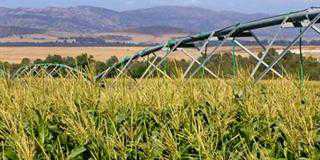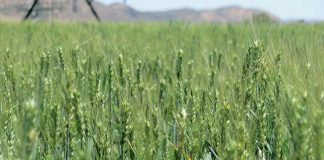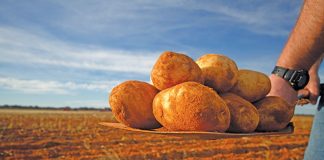
“We were concerned about damage to our arable soil from decades of conventional tillage,” says Henk Conradie, general manager and shareholder of Dries Cronje CC – a farming operation which consists of three farms in Ogies, three in Kriel and three in Bethal in Mpumalanga. In total they comprise 2 100ha rainfed arable land and 1 200ha veld grazing.
Annual rainfall on these farms averages 750mm, and the arable soil is generally Avalon and Hutton with a clay content of 10% to 35%. But below this good arable land ironically lie equally good coal seams which have led to another headache – farming in close proximity to mines and power stations.
“In order to attract skilled workers and tractor operators, we had to pay higher wages than we could afford,” says Henk, who lives on the farm Klippoortjie near Ogies with his wife Jenny, son Waldo and daughter Amone. With a BSc degree in agriculture from the University of the Free State, Henk comes from a farming background.
His late father Edward Hugo was a sugar cane grower near Eshowe in KwaZulu-Natal. During the July and December university holidays Henk worked as a student for Dries Cronje. In July 1990, after completing his military service, he joined Dries on a permanent basis when the farming operation encompassed only 350ha.
Adopting no-till
‘‘Seven years ago, Dries and I started no-till and conservation agriculture (CA) trials on selected portions of the farms,” says Henk.
“CA held the promise of increasing the soil’s organic matter content and microbial life, decreasing water and wind erosion, and reducing our tractor needs by half.“
As the trials showed definite benefits, they adopted no-till practices on all the farms three years later, planting a third of the arable land to open-pollinated maize, a third to Roundup Ready maize and a third to Roundup Ready soya beans in a three-year crop rotation cycle.
“While open-pollinated maize requires more insecticide applications, it is less expensive than Bt maize, which is in any case not entirely effective in combating stalk borer as it still sometimes needs to be sprayed.” While double stacked gene maize was even more expensive, it was necessary in the rotation.
The three-year crop rotation cycle started with open-pollinated maize after the previous cycle’s volunteer Roundup Ready soya beans had been killed by a 2,4-D application in Roundup Ready maize, and the open-pollinated volunteers were killed by spraying Roundup in Roundup Ready soya beans.
“Our average long-term maize yield was 5,5t/ ha, but has increased to 6t/ ha over the last three years,” explains Henk. “Depending on the season, the soya bean yield has fluctuated between 2t/ha and 3t/ha. After adopting no-till, we noted a slight decline in yield but this has now increased to above the previous average.
“Another major benefit of no-till is that, even though this season started off with little rain, we could achieve excellent germination due to the moisture retained under the previous season’s crop residue. “The crops looked good despite having received only 235mm of rain up to 25 January.”
New crop rotation
Henk will implement a new rotation system next season by planting 50% of the lands to open-pollinated maize, of which half will be white and half yellow, and the remaining 50% to Roundup Ready soya beans. This will further reduce input costs as they will not plant any expensive GM maize and the Roundup applied to the Roundup Ready soya beans will kill volunteer open-pollinated maize plants.
“When the first weeds that emerge after the soya bean harvest reach the four-leaf stage in August/September, we will spray 3l/ha Roundup Turbo, 0,5l/ ha 2,4-D, 2l/ha ammonium sulphate and 25ml/ha Stilwett. A second spraying later, if needed, will be 3l/ ha Roundup Turbo and 2l/ha ammonium sulphate.
“A too-low Roundup dosage could lead to herbicide resistance in weeds, as some farmers in Western Cape have found to their detriment.” Every second year, Henk will grid-sample the lands previously planted to soya beans and due to be planted to maize, and correct any mineral imbalance – mainly calcium, potassium and phosphorus – by means of a fertiliser and lime spreader drawn by a GPS-equipped tractor. In the year in-between the grid sampling, they will apply 9kg of phosphorus and 18kg of potassium per ton of soya beans harvested to maintain soil fertility for the coming maize crop.
Maize will be planted no-till in 70cm rows for a plant density of 45 000/ ha to 47 000/ha from 10 October onwards, depending on rainfall. In the coming season – the transition from the two-thirds maize and one-third soya beans to half maize and half soya bean rotation – planters used on lands previously under maize will be equipped with fertiliser tines modified to work at a depth of 250mm to 300mm.
They will be arranged in a paraplow configuration to lift and shatter, with minimum soil disturbance, any compaction areas created by cattle grazing on the maize stover under the previous rotation system. At planting, 400kg/ ha of 5:3:4 (20) fertiliser will be applied with 1,5l/h Guardian S and 40ml/ ha Sumi-Alpha with a buffer.
Four to six weeks later, a 250kg/ha top dressing containing 65,5kg nitrogen and 15kg sulphur will follow. “With 33kg/ ha nitrogen at planting, 65,5kg/ ha as top dressing and assuming 20kg/ha fixed by the previous soya bean crop, 118,5kg/ha nitrogen will be available to the maize,” explains Henk.
After planting, they will spray 1,8l/ ha Terbuzine 600, 800ml/ ha Harness Extra and 200ml/ ha 2,4-D for grasses and broadleaf weeds. If stalk borer is present, they will spray 120ml/ha Lamda. During this application they will also trial Abacus at 1,6l/ha to control fungal diseases such as white rust and northern leaf blight, as well as to increase drought resistance and increase yield.
Should a second generation of stalk borer appear later in the season, they will aerially spray Lamda at 150ml/ha. The maize will be harvested in late May, using a combine harvester fitted with a 10-row maize header and equipped with a yield monitor. After harvesting the maize lands, the farming operations’ 800 Bonsmara cross-bred cows will graze the maize stover until they start consuming the salt licks.
Around 65% of the maize residue should still be left on the land as soil cover to inhibit weed growth, retain moisture, reduce soil temperature fluctuations, and build up soil organic matter and microbial life. When the first weeds reach the four-leaf stage, normally during August and September, they will spray 3l/ha Roundup Turbo, 2l/ha ammonium sulphate and 25ml/ ha Stilwett.
Unlike on maize lands, no 2,4-D will be applied as its residue affects soya beans. The second pre-plant spraying will consist of 750ml/ha Frontier to keep the lands weed-free for a longer period. In the next rotation, starting on 10 October, depending on rainfall, soya beans will be planted in 70cm rows for a plant density of 350 000/ha to 400 000/ha using no-till planters with standard tines.
Stimuplant, a rhizobium inoculant mixed with water, will be applied at 600g/ha, fed directly onto the soya bean seeds in the planting furrow during planting. This stimulates rhizobia bacteria in the root nodules to produce nitrogen, making nitrogen application unnecessary. Any nitrogen unused by the soya bean crop will remain in the soil to benefit the following maize crop.
The first flush of weeds after planting Roundup Ready soya beans will be sprayed with Roundup Ready at 2l/ha and ammonium sulphate at 2l/ ha. If weeds are present before the soya bean rows close up, a second spraying of 2l/ha Roundup Ready and 2l/ ha ammonium sulphate will follow. Bollworm will be sprayed with 150ml/ha Lamda and, just before the soya beans start flowering, a 1l/ ha Abacus spray, followed 21 days later by a second application, will combat scleriotina fungus.
This will only apply if bollworm is present. The soya beans will be harvested in April or May using a yield monitor equipped combine harvester fitted with a 7,5m flexi-head header. Harvesting contractors are brought in to assist with the harvesting of soya beans.
Cover crops
Henk explains that as soya beans leave less crop residue than maize, they are considering planting cover crops. One such crop is ryegrass, which could be broadcast into the soya bean crop two weeks before harvesting when the soya bean leaves have dropped to allow sufficient sunlight penetration for the ryegrass. The ryegrass could then be killed off with Roundup Turbo about two weeks before planting the next maize crop.
Livestock theft no deterrent
With the coal mine and power stations of the Ogies and Kriel districts in close proximity, farm homestead and livestock security had to be increased and a security company now patrols each farm in the area with GPS-equipped vehicles. Recently, one of Henk’s neighbours lost seven cattle due to cruelty and attempted theft.
But despite the problem, Dries Cronje CC runs a herd of 800 Bonsmara cross-bred cows to produce weaners for feedlots at between eight and nine months. The herd grazes on veld in summer and on maize and soya bean residue in winter, when it is also fed on Eragrostis hay grown and baled on 80ha pasture and waterways. When they are old enough, the weaners are supplemented with crushed maize grain in in-field cribs.
Contact Henk Conradie on 082 825 5042 or email [email protected]













